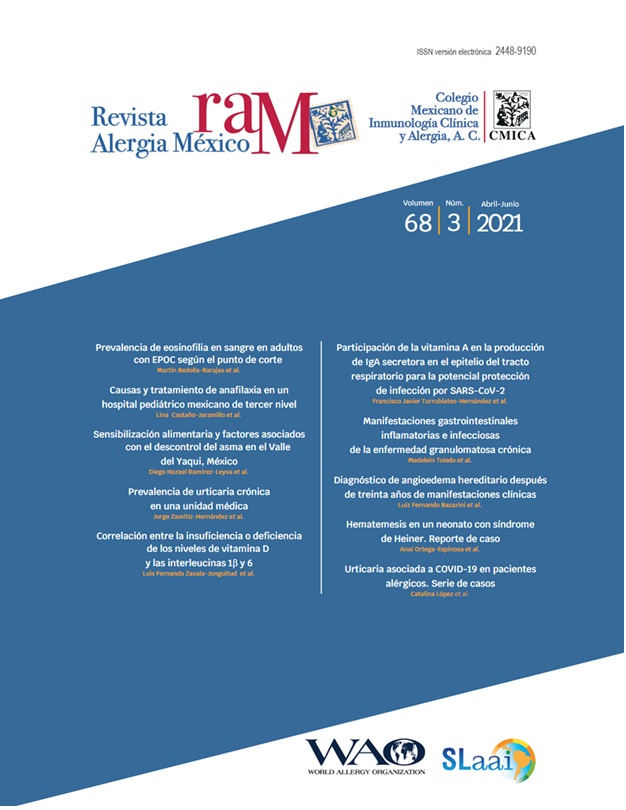Abstract
Introduction: Diagnosis and treatment of hereditary angioedema (HAE) are necessary to improve the quality of life and even the survival of patients.
Case report: A 52-year-old woman with angioedema for 30 years, which affects the face, tongue, and hands. It is asymmetric, with neither pruritus nor urticaria, without response to antihistamines or corticosteroids, with spontaneous resolution in 48 hours to 72 hours; with a family history of angioedema. Normal physical examination between exacerbations. Autoimmune and lymphoproliferative diseases were ruled out. Values of C1q, C4, C1-INH were normal. The diagnosis of HAE type C1-INH normal subtype Unknown was established. The total resolution of the crises was achieved after two months with androgen therapy. Outpatient follow-up has been given for four years and no angioedema crisis has been reported, which is associated with a radical change in the quality of life.
Conclusions: The patient was diagnosed with HAE after 30 years of clinical manifestations, after acquired angioedema was ruled out.
References
Holguín-Gómez LM, Vásquez-Ochoa LA, Cardona R. Angioedema. Rev Alerg Mex. 2016;63(4):373-384. Disponible en: https://revistaalergia.mx/ojs/index.php/ram/article/view/220/384
Araujo A, Pinto J, Almeida P, Pinheiro B, Morete A. Angioedema hereditário: a importância da suspeita clínica e do tratamento adequado. Medicina Interna (Lisboa). 2018;25(1):40-42. DOI:10.24950/rspmi/CC/146/1/2018
Giavina-Bianchi P, Arruda LK, Aun MV, Campos RA, Chong-Neto HJ, Constantino-Silva RN, et al. Diretrizes brasileiras para o diagnóstico e tratamento do angioedema hereditário. Arq Asma Alerg Imunol. 2017;1(1):23-48. DOI: 10.5935/2526-5393.20170005
Neves-Forte WC. Imunologia do básico ao aplicado. Brasil: Editora Atheneu; 2015.
Larrauri B, Hester CG, Jiang H, Malbran A, Bork K, Kaplan A, et al. Sgp120 and the contact system in hereditary angioedema: a diagnostic tool in HAE with normal C1 inhibitor. Mol Immunol. 2020;119:27-34. DOI: 10.1016/j.molimm.2020.01.003
Henao MP, Kraschnewski JL, Kelbel T, Craig TJ. Diagnosis and screening of patients with hereditary angioedema in primary care. The Clin Risk Manag. 2016;12:701-711. DOI: 10.2147/TCRM.S86293
Bork K, Barnstedt SE, Koch P, Traupe H. Hereditary angioedema with normal C1-inhibitor activity in women. Lancet. 2000;356(9225):213-217. DOI: 10.1016/S0140-6736(00)02483-1
Guimarães PV, Bastos RM, Valle SOR, Neves ARR, Levy SAP, Reis FAA, et al. Angioedema hereditário com inibidor de C1 normal-relato de caso e revisão de literatura. Rev Bras Alerg Imunopatol. 2007;30(6):247-249.
Maurer M, Magerl M, Ansotegui I, Bowen T, Potter P, Zuraw B, et al. The international WAO/EAACI guideline for the management of hereditary angioedema – The 2017 revision and update. Allergy. 2018;73(8):1575-1596. DOI: 10.1111/all.13384
Busse PJ, Christiansen SC, Riedl MA, Banerji A, Bernstein J, Castaldo AJ, Craig T, et al. US HAEA medical advisory board 2020 guidelines for the management of hereditary angioedema. J Allergy Clin Immunol Pract. 2021;9(1):132-150. DOI: 10.1016/j.jaip.2020.08.046

This work is licensed under a Creative Commons Attribution-NonCommercial 4.0 International License.
Copyright (c) 2021 Revista Alergia México

